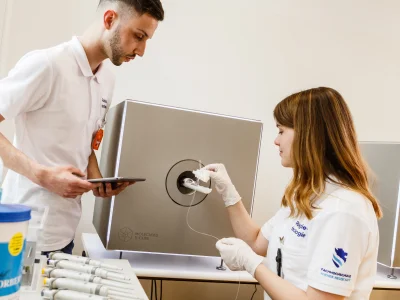The main focus comprises the quantification and visualization of anatomical and structural information, as well as complex biochemical processes at the cellular and molecular level in living cells, biological and artificial tissues and in the living organism using morphological, functional and molecular imaging techniques, including the development and evaluation of novel imaging biomarkers and methods for specific (patho)physiological processes.
Another focus is on the carrying out of laboratory analytical tests as part of the biomedical analysis process. The main focus here is on (immuno)histological investigations of a wide variety of tissue samples, including digitalization of the results as well as the performance of titer studies.
We perform research and development in the following topics:
- Development and evaluation of imaging techniques to facilitate the understanding of the systems biology of different tumor entities
- Visualization and quantification of highly specific tumor(patho)physiological properties using radiolabeled biomarkers and their combination with multimodal preclinical morphological, functional and molecular imaging techniques (micro-CT, micro-SPECT, micro-PET and micro-MRI)
- Application, establishment and validation of preclinical molecular and semi-functional imaging methods in radiotherapy and their use in applied research in the field of biomedicine, radiobiology and medical radiation physics
- Investigation of complex biological systems and bioinformatic data analysis
- Investigation of imaging biomarkers and the effect of drugs at the molecular level
- NGS data analysis in personalized medicine (genomics, metagenomics and transcriptomics)
Infrastructure:
- micro-Computed Tomography (X-Cube, Molecubes)
- micro-Positron Emission Tomography (b-Cube, Molecubes)
- micro-Single Photon Emission Tomography (g-Cube, Molecubes)
- micro-Magnetic Resonance Tomography (15.2T UHF, Bruker BioSpin)
- Biomedical image data analysis, reconstruction and complex intelligent systems
- Image Post-Processing Laboratory
- Small Animal Housing Unit
- Ultrasound Laboratory
- Radiotherapy Laboratory
- Nuclear Medicine Laboratory
- Intervention Laboratory
- X-ray and Mammography Laboratory
- Biomedical Analytics Training Laboratories
- LC-HRMS
- Nano LC-MS/MS
- HPLC
- GC-MS

Contact
Feel free to contact us: FuE@fhwn.ac.at
